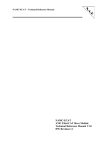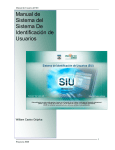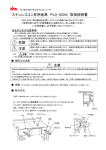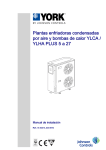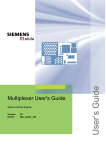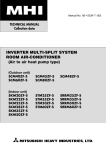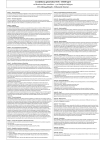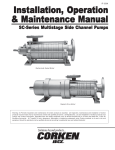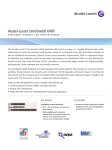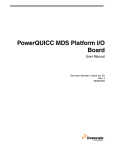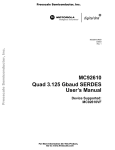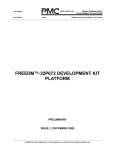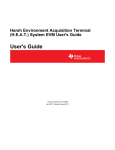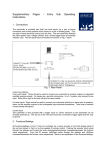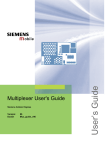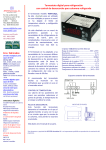Download NAMC-STM1_4_manual
Transcript
NAMC-STM1/4 – Technical Reference Manual NAMC-STM1/4 Telecom AMC Module Technical Reference Manual V1.3 HW Revision 1.4 NAMC-STM1/4 – Technical Reference Manual The NAMC-STM1/4 has been designed by: N.A.T. GmbH Kamillenweg 22 D-53757 Sankt Augustin Phone: ++49/2241/3989-0 Fax: ++49/2241/3989-10 E-Mail: [email protected] Internet: http://www.nateurope.com Version 1.3 © N.A.T. GmbH 2 NAMC-STM1/4 – Technical Reference Manual Disclaimer The following documentation, compiled by N.A.T. GmbH (henceforth called N.A.T.), represents the current status of the product´s development. The documentation is updated on a regular basis. Any changes which might ensue, including those necessitated by updated specifications, are considered in the latest version of this documentation. N.A.T. is under no obligation to notify any person, organization, or institution of such changes or to make these changes public in any other way. We must caution you, that this publication could include technical inaccuracies or typographical errors. N.A.T. offers no warranty, either expressed or implied, for the contents of this documentation or for the product described therein, including but not limited to the warranties of merchantability or the fitness of the product for any specific purpose. In no event will N.A.T. be liable for any loss of data or for errors in data utilization or processing resulting from the use of this product or the documentation. In particular, N.A.T. will not be responsible for any direct or indirect damages (including lost profits, lost savings, delays or interruptions in the flow of business activities, including but not limited to, special, incidental, consequential, or other similar damages) arising out of the use of or inability to use this product or the associated documentation, even if N.A.T. or any authorized N.A.T. representative has been advised of the possibility of such damages. The use of registered names, trademarks, etc. in this publication does not imply, even in the absence of a specific statement, that such names are exempt from the relevant protective laws and regulations (patent laws, trade mark laws, etc.) and therefore free for general use. In no case does N.A.T. guarantee that the information given in this documentation is free of such third-party rights. Neither this documentation nor any part thereof may be copied, translated, or reduced to any electronic medium or machine form without the prior written consent from N.A.T. GmbH. This product (and the associated documentation) is governed by the N.A.T. General Conditions and Terms of Delivery and Payment. Note: The release of the Hardware Manual is related to a certain HW board revision given in the document title. For HW revisions earlier than the one given in the document title please contact N.A.T. for the corresponding older Hardware Manual release. Version 1.3 © N.A.T. GmbH 3 NAMC-STM1/4 – Technical Reference Manual Table of Contents LIST OF TABLES ................................................................................................................................................ 5 LIST OF FIGURES .............................................................................................................................................. 6 CONVENTIONS................................................................................................................................................... 7 1 INTRODUCTION ....................................................................................................................................... 8 1.1 BOARD FEATURES .............................................................................................................................. 10 1.1.1 FPGA ............................................................................................................................................ 10 1.1.2 SDH Interfaces .............................................................................................................................. 10 1.1.3 Backplane Interfaces ..................................................................................................................... 10 1.2 BOARD SPECIFICATION ....................................................................................................................... 12 2 INSTALLATION ...................................................................................................................................... 13 2.1 SAFETY NOTE ..................................................................................................................................... 13 2.2 INSTALLATION PREREQUISITES AND REQUIREMENTS ......................................................................... 14 2.2.1 Requirements................................................................................................................................. 14 2.2.2 Power supply................................................................................................................................. 14 2.2.3 Automatic Power Up ..................................................................................................................... 14 2.3 STATEMENT ON ENVIRONMENTAL PROTECTION ................................................................................. 15 2.3.1 Compliance to RoHS Directive ..................................................................................................... 15 2.3.2 Compliance to WEEE Directive .................................................................................................... 15 2.3.3 Compliance to CE Directive ......................................................................................................... 16 2.3.4 Product Safety ............................................................................................................................... 16 3 FUNCTIONAL BLOCKS......................................................................................................................... 17 3.1.1 FPGA ............................................................................................................................................ 17 3.1.2 PCI Express Interface ................................................................................................................... 17 3.1.3 Backplane Ethernet ....................................................................................................................... 17 3.1.4 iTDM ............................................................................................................................................. 17 3.1.5 Backplane TDM ............................................................................................................................ 18 3.2 SDH LINE INTERFACES ....................................................................................................................... 18 3.3 AMC CLOCK INTERFACE .................................................................................................................... 18 3.4 IPMB INTERFACE ............................................................................................................................... 19 3.4.1 I2C Devices.................................................................................................................................... 19 4 HARDWARE............................................................................................................................................. 20 4.1 4.2 5 AMC PORT DEFINITION...................................................................................................................... 20 FRONT PANEL AND LEDS ................................................................................................................... 21 CONNECTORS......................................................................................................................................... 22 5.1 5.2 5.3 5.4 5.5 Version 1.3 CONNECTOR OVERVIEW ..................................................................................................................... 22 AMC CONNECTOR J1 ......................................................................................................................... 23 CONNECTOR JP1: IPMI-µC PROGRAMMING PORT .............................................................................. 25 CONNECTOR JP2: LATTICE FPGA PROGRAMMING PORT .................................................................... 25 CONNECTOR JP3: JTAG CONNECTOR ................................................................................................. 26 © N.A.T. GmbH 4 NAMC-STM1/4 – Technical Reference Manual 5.6 5.7 6 HOT SWAP SWITCH SW1 .................................................................................................................... 26 THE FRONT PANEL CONNECTORS (S1 – S2)........................................................................................ 26 NAMC-STM1/4 PROGRAMMING NOTES .......................................................................................... 27 6.1.1 FPGA GP Registers/Status............................................................................................................ 28 6.1.1.1 6.1.1.2 6.1.1.3 6.1.1.4 6.1.1.5 6.1.1.6 6.1.1.7 6.1.1.8 6.1.1.9 6.1.1.10 6.1.1.11 6.1.1.12 6.1.1.13 6.1.1.14 6.1.1.15 6.1.1.16 6.1.2 7 PCB Version Register ......................................................................................................................... 28 FPGA Version Register....................................................................................................................... 28 FPGA ID_1 Register ........................................................................................................................... 28 FPGA ID_2 Register ........................................................................................................................... 28 FPGA BOARD_ID Register ............................................................................................................... 29 PLL Status Register............................................................................................................................. 29 IRQ Status Register ............................................................................................................................. 29 IRQ Enable Register............................................................................................................................ 29 FPGA Reset Register........................................................................................................................... 30 GP LEDs Register ............................................................................................................................... 30 AMC LEDs Register ........................................................................................................................... 30 PLL Control Register .......................................................................................................................... 31 Misc Clock Config Register ................................................................................................................ 32 SBI-bus Mode Register ....................................................................................................................... 32 AMC-Clock Output Register............................................................................................................... 33 AMC Site Number............................................................................................................................... 33 FPGA GbE/iTDM Configuration .................................................................................................. 34 KNOWN BUGS / RESTRICTIONS ........................................................................................................ 35 APPENDIX A: REFERENCE DOCUMENTATION...................................................................................... 36 APPENDIX B: DOCUMENT’S HISTORY...................................................................................................... 37 List of Tables Table 1: Table 2: Table 3: Table 4: Table 5: Table 6: Table 7: Table 8: Table 9: Table 10: Table 11: Table 12: Table 13: Table 14: Table 15: Table 16: Table 17: Table 18: Table 19: Table 20: Version 1.3 List of used abbreviations ...................................................................................... 7 NAMC-STM1/4 Features..................................................................................... 12 AMC Port Definition............................................................................................ 20 LED Functionality................................................................................................ 21 AMC Connector J1............................................................................................... 23 Atmel AVR Programming Port............................................................................ 25 Lattice programming port..................................................................................... 25 JTAG Connector Pinout ....................................................................................... 26 FPGA Memory Map............................................................................................. 27 PCB Version Register .......................................................................................... 28 FPGA Version Register........................................................................................ 28 FPGA ID_1 Register ............................................................................................ 28 FPGA ID_2 Register ............................................................................................ 28 FPGA BOARD_ID Register ................................................................................ 29 PLL Status Register.............................................................................................. 29 IRQ Status Register.............................................................................................. 29 IRQ Enable Register............................................................................................. 29 FPGA Reset Register ........................................................................................... 30 GP LEDs Register ................................................................................................ 30 GP LEDs Values .................................................................................................. 30 © N.A.T. GmbH 5 NAMC-STM1/4 – Technical Reference Manual Table 21: Table 22: Table 23: Table 24: Table 25: Table 26: Table 27: Table 28: Table 29: Table 30: Table 31: Table 32: AMC LEDs Register ............................................................................................ 30 AMC LED Values................................................................................................ 31 PLL Control Register ........................................................................................... 31 PLL Control - Register Bits ................................................................................. 31 Misc Clock Config Register................................................................................. 32 Misc Clock Config - Register Bits ....................................................................... 32 SBI-bus Mode Register ........................................................................................ 32 SBI-bus Mode - Register Bits .............................................................................. 32 AMC-Clock Output Register ............................................................................... 33 AMC-Clock Output Register Bits ........................................................................ 33 AMC Site Number ............................................................................................... 33 SBI-bus Timeslot Parameter ................................................................................ 34 List of Figures Figure 1: Figure 2: Figure 3: Figure 4: Figure 5: Figure 6: Version 1.3 NAMC-STM1/4 Block Diagram............................................................................ 9 Organisation of the iTDM FPGA......................................................................... 17 I²C Structure of the NAMC-STM1/4 ................................................................... 19 Front Panel ........................................................................................................... 21 Connectors of the NAMC-STM1/4...................................................................... 22 Organisation of the (i)TDM FPGA ...................................................................... 34 © N.A.T. GmbH 6 NAMC-STM1/4 – Technical Reference Manual Conventions If not otherwise specified, addresses and memory maps are written in hexadecimal notation, identified by 0x. Table 1 gives a list of the abbreviations used in this document: Table 1: List of used abbreviations Abbreviation Description b B CPLD CPU DDR DMA DRAM E1 FLASH FPGA H.110 iTDM J1 LIU MCH MPC8560 µTCA PCIe PCI-X RAM ROM SDRAM SMC T1 TDM TSI TSA Bit, binary byte Complex Programmable Logic Device Central Processing Unit Dual Data Rate Direct Memory Access Dynamic RAM 2.048 Mbit G.703 Interface Reprogrammable ROM Field Programmable Gate Array Time-Slot Interchange Bus internal TDM 1,544 Mbit G.703 Interface (Japan) Line Interface Unit µTCA Carrier Hub Embedded Processor from Freescale Micro Telecommunications Computing Architecture PCI Express Extended PCI Random Access Memory Read Only Memory Synchronous Dynamic RAM Serial Communication Controller of the MPC8560 1,544 Mbit G.703 Interface (USA) Time Division Multiplex Time Slot Interchange Time Slot Assigner Version 1.3 © N.A.T. GmbH 7 NAMC-STM1/4 – Technical Reference Manual 1 Introduction The NAMC-STM1/4 is a high performance standard Advanced Mezzanine Card, single width, double height for SDH/Sonet applications. It can be plugged onto any ATCA carrier board supporting AMC standards. It is also designed to meet the requirements of µTCA systems. General features: • Dual Optical Interface for STM1/4 / OC3/12 at 155/622 Mbit/sec • Add/Drop Multiplexer for up to 4*63=252E1 / 4*84=336T1 Channels • 63 E1 Framers or 84 T1 Framers per Temux device (up to 4 assembled) • Multiplexer cross connect between STM1/4 E1/T1 payload timeslots and iTDM timeslots (capacity limited to one STM4) • 1 Lane PCI Express Interface Rev. 1.1 • 1000BaseBX iTDM Interface • H.110 alike Backplane TDM bus • Configuration/Control via PCIe or via Ethernet Features of the Line Interface Circuits: • Clock recovery and jitter attenuation • Line and path performance monitoring Features of the iTDM circuit: • Flexible routing of any time slot between each of the framers and the iTDM controller • Capacity of up to 8192 timeslots Options: Version 1.3 • • • Single or Dual Optical Interface Single – or Multi-Mode optical Transceiver Monitoring Version (dual add/drop multiplexer) for concurrent Rx/Tx monitoring © N.A.T. GmbH 8 NAMC-STM1/4 – Technical Reference Manual Figure 1 shows a detailed block diagram of the NAMC-STM1/4. Figure 1: Version 1.3 NAMC-STM1/4 Block Diagram © N.A.T. GmbH 9 NAMC-STM1/4 – Technical Reference Manual 1.1 Board Features 1.1.1 FPGA The central component on the NAMC-STM1/4 is a Lattice SCM FPGA (SCM40 or SCM80). This device features built-in SerDes units used to realize the physical layer of the PCIe and the GbE interfaces, as well as a structured ASIC region used to implement the higher layers of the PCIe interface. The logic resources are used to realize the iTDM engine along with the management interface and further functionality related to the SDH chipset. 1.1.2 SDH Interfaces The STM1/4 / OC3/12 interface consists of the Fiber Optic interface and the Sonet/SDH framer. The PMC-Sierra device Arrow-155 is used as Sonet/SDH framer for the STM1 option, the Arrow-622 as framer for the STM4 option. The Arrow-155 is a single port Sonet/SDH framer supporting the OC-3 (STM-1) data rates. The Arrow-155 terminates section, line and path overhead of both the STS-n (AU-4) level and the TU-3 level. On the line side it incorporates a SERDES, allowing it to mate directly to an optics module. The system side interface is an 8-bit multi-drop parallel Telecom bus, allowing multiple devices to share a single bus. The Arrow-155 maps/demaps up to three channels of DS3, E3, or EC-1 with bi-directional monitoring of traffic. The traffic may be multiplexed either into the system side or line side interfaces. For the STM4 option, the board is equipped with an Arrow-622 device. 1.1.3 Backplane Interfaces PCIe: The NAMC-STM1/4 includes a x1-PCI Express interface. This is implemented in the Lattice FPGA. The PCI Express interface connects to Port 4/8 of the Fat Pipe Region of the AMC backplane connector (can be switched over to support redundant system setups). The implementation of PCIe conforms to the AMC.1 specification. GbE: The NAMC-STM1/4 implements a serial Type P Control Path, the physical layer of which is 1000BaseX. The Type P Control Path connects to Port 0/1 of the Common Options Region of the AMC backplane connector (can be switched over to support redundant system setups). The Control Path is connected to the iTDM FPGA, and shares the port with iTDM. iTDM: The NAMC-STM1/4 implements a serial iTDM backplane interface, the physical layer of which is 1000BaseX. The iTDM interface connects to Port 0/1 of the Common Options Region of the AMC backplane connector, and shares the port with the Type P Control Path. The iTDM Version 1.3 © N.A.T. GmbH 10 NAMC-STM1/4 – Technical Reference Manual interface is implemented in FPGA logic and conforms to the SFP.0 and SFP.1 specifications. IPMB: The NAMC-STM1/4 implements an IPMB interface which conforms to the AMC.0 specification. TDM: The NAMC-STM1/4 implements an 8 bit TDM interface, similar to H.110. The same throughput as with a complete H.110 bus is achieved by clocking the 8 backplane TDM lines with 32,768 MHz. Thus, every frame consists of 512 timeslots per line. The purpose of this TDM backplane bus is to establish ‘private’ TDM links to adjacent modules. The TDM interface is implemented in FPGA logic. The TDM interface connects to ports 12, 13 (data), and port 14 (Sync) of the Common Options Region of the AMC connector. Version 1.3 © N.A.T. GmbH 11 NAMC-STM1/4 – Technical Reference Manual 1.2 Board Specification Table 2: NAMC-STM1/4 Features AMC-Module standard Advanced Mezzanine Card, single width, double height Front-I/O Two optical 155/622Mbps OC-3/12 STM-1 line interfaces Power consumption 12V 1.3A max. Environmental conditions Temperature (operating): 0°C to +50°C with forced cooling Temperature (storage): -40°C to +85°C Humidity: 10 % to 90 % rh noncondensing Standards compliance PICMG AMC.0 Rev. 2.0 PICMG AMC.1 Rev. 1.0 PCI Express Base Specification Rev. 1.1 PICMG SFP.0 Rev. 1.0 (System Fabric Plane Format) PICMG SFP.1 Rev. 1.0 (Internal TDM) IPMI Specification v2.0 Rev. 1.0 PICMG µTCA.0 Rev. 1.0 Version 1.3 © N.A.T. GmbH 12 NAMC-STM1/4 – Technical Reference Manual 2 Installation 2.1 Safety Note To ensure proper functioning of the NAMC-STM1/4 during its usual lifetime take the following precautions before handling the board. CAUTION Electrostatic discharge and incorrect board installation and uninstallation can damage circuits or shorten their lifetime. • Before installing or uninstalling the NAMC-STM1/4 read this installation section • Before installing or uninstalling the NAMC-STM1/4, read the Installation Guide and the User’s Manual of the carrier board used, or of the uTCA system the board will be plugged into. • Before installing or uninstalling the NAMC-STM1/4 on a carrier board or both in a rack: - Check all installed boards and modules for steps that you have to take before turning on or off the power. - Take those steps. - Finally turn on or off the power if necessary. - Make sure the part to be installed / removed is hot swap capable, if you don’t switch off the power. • Before touching integrated circuits ensure to take all require precautions for handling electrostatic devices. • Ensure that the NAMC-STM1/4 is connected to the carrier board or to the uTCA backplane with the connector completely inserted. • When operating the board in areas of strong electromagnetic radiation ensure that the module - is bolted the front panel or rack - and shielded by closed housing Version 1.3 © N.A.T. GmbH 13 NAMC-STM1/4 – Technical Reference Manual 2.2 Installation Prerequisites and Requirements IMPORTANT Before powering up • check this section for installation prerequisites and requirements 2.2.1 Requirements The installation requires only • an ATCA carrier board, or a µTCA backplane for connecting the NAMCSTM1/4 • power supply • cooling devices 2.2.2 Power supply The power supply for the NAMC-STM1/4 must meet the following specifications: • required for the module: +12V / 1.3A max. + 3,3V / 0.15A max. 2.2.3 Automatic Power Up In the following situations the NAMC-STM1/4 will automatically be reset and proceed with a normal power up. Voltage sensors The voltage sensor generates a reset • when +12V voltage level drops below 8V • when +3.3V voltage level drops below 3.08V or when the carrier board / backplane signals a PCIe Reset. Version 1.3 © N.A.T. GmbH 14 NAMC-STM1/4 – Technical Reference Manual 2.3 Statement on Environmental Protection 2.3.1 Compliance to RoHS Directive Directive 2002/95/EC of the European Commission on the "Restriction of the use of certain Hazardous Substances in Electrical and Electronic Equipment" (RoHS) predicts that all electrical and electronic equipment being put on the European market after June 30th, 2006 must contain lead, mercury, hexavalent chromium, polybrominated biphenyls (PBB) and polybrominated diphenyl ethers (PBDE) and cadmium in maximum concentration values of 0.1% respective 0.01% by weight in homogenous materials only. As these hazardous substances are currently used with semiconductors, plastics (i.e. semiconductor packages, connectors) and soldering tin any hardware product is affected by the RoHS directive if it does not belong to one of the groups of products exempted from the RoHS directive. Although many of hardware products of N.A.T. are exempted from the RoHS directive it is a declared policy of N.A.T. to provide all products fully compliant to the RoHS directive as soon as possible. For this purpose since January 31st, 2005 N.A.T. is requesting RoHS compliant deliveries from its suppliers. Special attention and care has been paid to the production cycle, so that wherever and whenever possible RoHS components are used with N.A.T. hardware products already. 2.3.2 Compliance to WEEE Directive Directive 2002/95/EC of the European Commission on "Waste Electrical and Electronic Equipment" (WEEE) predicts that every manufacturer of electrical and electronical equipment which is put on the European market has to contribute to the reuse, recycling and other forms of recovery of such waste so as to reduce disposal. Moreover this directive refers to the Directive 2002/95/EC of the European Commission on the "Restriction of the use of certain Hazardous Substances in Electrical and Electronic Equipment" (RoHS). Having its main focus on private persons and households using such electrical and electronic equipment the directive also affects business-to-business relationships. The directive is quite restrictive on how such waste of private persons and households has to be handled by the supplier/manufacturer; however, it allows a greater flexibility in business-to-business relationships. This pays tribute to the fact with industrial use electrical and electronical products are commonly integrated into larger and more complex environments or systems that cannot easily be split up again when it comes to their disposal at the end of their life cycles. Version 1.3 © N.A.T. GmbH 15 NAMC-STM1/4 – Technical Reference Manual As N.A.T. products are solely sold to industrial customers, by special arrangement at time of purchase the customer agreed to take the responsibility for a WEEE compliant disposal of the used N.A.T. product. Moreover, all N.A.T. products are marked according to the directive with a crossed out bin to indicate that these products within the European Community must not be disposed with regular waste. If you have any questions on the policy of N.A.T. regarding the Directive 2002/95/EC of the European Commission on the "Restriction of the use of certain Hazardous Substances in Electrical and Electronic Equipment" (RoHS) or the Directive 2002/95/EC of the European Commission on "Waste Electrical and Electronic Equipment" (WEEE) please contact N.A.T. by phone or e-mail. 2.3.3 Compliance to CE Directive Compliance to the CE directive is declared. A ‘CE’ sign can be found on the PCB. 2.3.4 Product Safety The board complies with EN60950 and UL1950. Version 1.3 © N.A.T. GmbH 16 NAMC-STM1/4 – Technical Reference Manual 3 Functional Blocks The NAMC-STM1/4 can be divided into a number of functional blocks, which are described in the following paragraphs. 3.1.1 FPGA The FPGA implements the following functional blocks: • Logic to interface the SBI bus; clock management for the SDH chipset • iTDM controller with GbE. • PCIe interface for management • Management over GbE • Legacy TSI between SBI timeslots and backplane TDM bus 3.1.2 PCI Express Interface The NAMC-STM1/4 includes a 1 lane PCI Express interface. This is implemented in the Lattice SCM FPGA. The PCIe interface may receive its reference clock either from the Clock 3 port of the AMC backplane connector, or from a local 100 MHz oscillator circuitry (default). The clock source is programmable. 3.1.3 Backplane Ethernet The backplane Ethernet interface implemented within the FPGA can be switched to operate on AMC Port 0 or Port 1 for redundant operation. Within FPGA logic the Type P Control Path data is multiplexed with the iTDM data and transferred through the same physical port. By default, the LIU is programmed to connect to Port 0 of the Common Options Region of the AMC backplane connector. It can also be programmed to connect to Port 1, in order to support a redundant µTCA system. 3.1.4 iTDM The iTDM controller within the FPGA can be used to transfer any of the SDH timeslots via GbE packets. It supports mixed operation in either 125µs mode or 1ms mode. The capacity is limited to 8192 timeslots, due to the available bandwidth of the GbE link. Figure 2: Version 1.3 Organisation of the iTDM FPGA © N.A.T. GmbH 17 NAMC-STM1/4 – Technical Reference Manual 3.1.5 Backplane TDM The NAMC-STM1/4 implements an 8 bit TDM interface, similar to H.110. The same throughput as with a complete H.110 bus is achieved by clocking the 8 backplane TDM lines with 32,768 MHz. Thus, every frame consists of 512 timeslots per line. The purpose of this TDM backplane bus is to establish ‘private’ TDM links to adjacent modules. The TDM interface is implemented in FPGA logic. The TDM interface connects to ports 12, 13 (data), and port 14 (Sync) of the Extended Options Region of the AMC connector. 3.2 SDH Line Interfaces The two optical 155/622Mbps OC-3/12 STM-1 line interfaces are available on two standard OC-3/12 SDH/STM-1 SC-connectors at the front panel. 3.3 AMC Clock Interface The NAMC-STM1/4 implements a very flexible clocking functionality concerning the AMC backplane clock ports Clock 1 – Clock 3. AMC backplane clock port Clock 1 is connected to the FPGA, in order to be used as a Telecom standard clock. Clock 1 is only received. AMC backplane clock port Clock 2 is connected to the FPGA, in order to be used as a Telecom standard reference. Clock 2 may be received from or transmitted to the backplane, in order to become the reference clock for the entire system. AMC backplane clock port Clock 3 is connected to the PCIe interface, in order to be used as a reference clock for PCI Express. Clock 3 is only received. Clock 3 is routed to a multiplexer, which allows programming the clock source of the PCIe line to be either Clock 3, or an internal differential 100 MHz reference clock. In case clock 3 is to be used for a different functionality, it also feeds the FPGA and may be used there for any suitable purpose. Version 1.3 © N.A.T. GmbH 18 NAMC-STM1/4 – Technical Reference Manual 3.4 IPMB Interface The NAMC-STM1/4 implements an IPMB interface consisting of an ATMega168 microcontroller and a couple of I2C devices, such as a temperature sensor, and an EEPROM. The IPMB controller manages also the hot swap functionality and the geographical address as requested by the AMC specification. 3.4.1 I2C Devices Three I2C busses connect to the IPMI controller. The first one is the IPMB bus of the AMC connector, and the two other interface various local devices. The local devices, all powered by IPMB power, are an EEPROM (24C08) for storage of board-specific information, and a temperature sensor, which is capable of reading the FPGA’s die temperature. The third local I²C device is the hotswap controller of the NAMC-STM1/4. Figure 3: Version 1.3 I²C Structure of the NAMC-STM1/4 © N.A.T. GmbH 19 NAMC-STM1/4 – Technical Reference Manual 4 Hardware 4.1 AMC Port Definition Table 3: AMC Port Definition Extended Connector Basic Connector Port No. CLK1 CLK2 CLK3 0 1 2 3 4 5 6 7 8 9 10 11 12 13 14 15 CLK4/5 17 18 19 20 Version 1.3 AMC Port Mapping Strategy Clocks Common Options Region Fat Pipes Region Extended Options Region Ports used as Reference Clock 1 Reference Clock 2 Reference Clock 3 1000BaseX Ethernet Channel 1 (iTDM and Type P), default 1000BaseX Ethernet Channel 2 (iTDM and Type P), redundant unassigned unassigned PCI Express Lane 0, default unassigned unassigned unassigned PCI Express Lane 0, redundant unassigned unassigned unassigned TDM Bus D0-3 (H.110 extended) TDM Bus D4-7 (H.110 extended) optional clock lines (H.110 extended)/ unassigned Unassigned Unassigned Unassigned Unassigned Unassigned Unassigned © N.A.T. GmbH 20 NAMC-STM1/4 – Technical Reference Manual 4.2 Front Panel and LEDs The NAMC-STM1/4 module is equipped with 4 LEDs, which are software programmable. They are mounted between the SDH connectors. Additionally it features the standard four AMC LEDs, with the red and blue LED being controlled by the IPMB-µC, and the green and yellow one being controlled via FPGA registers. Figure 4: Front Panel Table 4: LED Functionality LED 1 2 3 4 blue red green yellow Version 1.3 Function no default functionality; can be controlled by software no default functionality; can be controlled by software no default functionality; can be controlled by software no default functionality; can be controlled by software AMC Hotswap LED AMC Error LED default: Lock Status PLL; can be overridden by software default: Activity Ethernet; can be overridden by software © N.A.T. GmbH 21 NAMC-STM1/4 – Technical Reference Manual 5 Connectors 5.1 Connector Overview Figure 5: Connectors of the NAMC-STM1/4 JP2 1 JP1 1 JP3 1 AMC LEDs S1 J 1 GP LEDs S2 SW1 Please refer to the following tables to look up the connector pin assignment of the NAMCSTM1/4. Version 1.3 © N.A.T. GmbH 22 NAMC-STM1/4 – Technical Reference Manual 5.2 AMC Connector J1 Table 5: AMC Connector J1 Version 1.3 Pin No. AMC-Signal AMC-Signal Pin No. 1 2 3 4 5 6 7 8 9 10 11 12 13 14 15 16 17 18 19 20 21 22 23 24 25 26 27 28 29 30 31 32 33 34 35 36 37 GND PWR /PS1 PWR_IPMB GA0 RESVD GND RESVD PWR GND XLINK1_P XLINK1_N GND RLINK1_P RLINK1_N GND GA1 PWR GND XLINK2_P XLINK2_N GND RLINK2_P RLINK2_N GND GA2 PWR GND NC NC GND NC NC GND NC NC GND 170 169 168 167 166 165 164 163 162 161 160 159 158 157 156 155 154 153 152 151 150 149 148 147 146 145 144 143 142 141 140 139 138 137 136 135 134 GND TDI TDO /TRST TMS TCK GND /SPISEL SPICLK GND SPIMOSI SPIMISO GND PORT19TX_P PORT19TX_N GND PORT19RX_P PORT19RX_N GND PORT18TX_P PORT18TX_N GND PORT18RX_P PORT18RX_N GND NC NC GND NC NC GND NC NC GND NC NC GND © N.A.T. GmbH 23 NAMC-STM1/4 – Technical Reference Manual Version 1.3 Pin No. AMC-Signal AMC-Signal Pin No. 38 39 40 41 42 43 44 45 46 47 48 49 50 51 52 53 54 55 56 57 58 59 60 61 62 63 64 65 66 67 68 69 70 71 72 73 74 75 76 77 78 NC NC GND /ENABLE PWR GND PET0_P_P4 PET0_N_P4 GND PER0_P_P4 PER0_N_P4 GND NC NC GND PER1_P PER1_N GND IPMB_SCL PWR GND NC NC GND NC NC GND NC NC GND NC NC GND IPMB_SDA PWR GND CLK_1_P CLK_1_N GND CLK_2_P CLK_2_N 133 132 131 130 129 128 127 126 125 124 123 122 121 120 119 118 117 116 115 114 113 112 111 110 109 108 107 106 105 104 103 102 101 100 99 98 97 96 95 94 93 NC NC GND NC NC GND RESVD TDM_REF GND TDM_FS TDM_CLK GND TDM7 TDM6 GND TDM5 TDM4 GND TDM3 TDM2 GND TDM1 TDM0 GND NC NC GND NC NC GND NC NC GND NC NC GND NC NC GND NC NC © N.A.T. GmbH 24 NAMC-STM1/4 – Technical Reference Manual Pin No. AMC-Signal AMC-Signal Pin No. 79 80 81 82 83 84 85 GND CLK_3_P CLK_3_N GND /PS0 PWR GND GND PET0_P_P8 PET0_N_P8 GND PER0_P_P8 PER0_N_P8 GND 92 91 90 89 88 87 86 5.3 Connector JP1: IPMI-µC Programming Port Connector JP1 connects the programming-port of the Atmel AVR µC device. Table 6: Atmel AVR Programming Port Pin No. Signal 1 2 3 4 5 6 MISO VCC_IPMB SCK MOSI /RST_IMPI GND 5.4 Connector JP2: Lattice FPGA programming port Connector JP2 connects the JTAG- or programming-port of the Lattice FPGA device. Table 7: Lattice programming port Version 1.3 Pin No. Signal Signal Pin No. 1 3 5 7 9 +3.3V TDI nc GND DONE_LAT TDO /PROGRAM TMS TCK /INIT_LAT 2 4 6 8 10 © N.A.T. GmbH 25 NAMC-STM1/4 – Technical Reference Manual 5.5 Connector JP3: JTAG connector This JTAG port connects to the JTAG interfaces of the Arrow and Temux devices, which are configured in a daisy chain. Table 8: JTAG Connector Pinout Pin No. Signal Signal Pin No. 1 3 5 7 9 TCK TDO TMS nc TDI GND +3,3V nc nc GND 2 4 6 8 10 5.6 Hot Swap Switch SW1 Switch SW1 is used to support hot swapping of the module. It conforms to PICMG AMC.0. 5.7 The Front Panel Connectors (S1 – S2) The two optical front panel connectors have standard SC-plugs, and can be equipped with either singlemode or multimode transceivers. Version 1.3 © N.A.T. GmbH 26 NAMC-STM1/4 – Technical Reference Manual 6 NAMC-STM1/4 Programming Notes The FPGA on the NAMC-STM1/4 realizes the interface to the onboard devices and an iTDM-to-TDM conversion engine. The table below shows the memory map for the logical sub-blocks of the design. Refer to the following sub-chapters for detailed information. All devices shown in this memory map can be accessed either via PCIe or via the so called Ethernet Control Interface. This Interface uses a N.A.T. proprietary protocol based on Layer2 Ethernet frames to perform memory mapped accesses via Ethernet. Please refer to the Ethernet Control Interface Technical Reference Manual for further information [9]. The MAC address of the NAMC-STM1/4 is build with the following scheme: 00:40:42:14:XX:XX with XXXX being the boards serial number in hexadecimal representation Table 9: FPGA Memory Map Address Offset 0x00000 0x00100 0x01000 0x08000 0x0c000 0x10000 0x14000 0x18000 0x1c000 0x20000 0x80000 Logical Block General Purpose Status (read-only) General Purpose Registers Interface to SPI FPGA PROM Arrow Framer 0 Arrow Framer 1 Temux 0 Temux 2 Temux 1 Temux 3 GbE-Interface Block iTDM Block The FPGA-Design consists of four main blocks: • Misc. board control- and status registers, and a register-interface to access the FPGA’s PROM • Ethernet Control Interface • Interface to Arrow and Temux Devices • GbE-MAC and frame preprocessing block • iTDM block Version 1.3 © N.A.T. GmbH 27 NAMC-STM1/4 – Technical Reference Manual 6.1.1 FPGA GP Registers/Status This chapter describes the basic board control registers implemented within the FPGA. Further register description will follow up in future versions of this manual. 6.1.1.1 PCB Version Register The Version Register holds the PCB Revision, encoded in two nibbles. Table 10: PCB Version Register PCB Version - Address 0x00 Default value 0x0011 Bit Access Func 15..8 7..4 3..0 R R R reserved Version Major Version Minor 6.1.1.2 FPGA Version Register The Version Register holds the FPGA Revision, encoded in two nibbles. Table 11: FPGA Version Register FPGA Version - Address 0x02 Default value 0x0015 Bit Access Func 15..8 7..4 R R 3..0 R reserved Version Major Version Minor 6.1.1.3 FPGA ID_1 Register This read only register can be used by the device driver to probe register access. Table 12: FPGA ID_1 Register FPGA ID_1 - Address 0x04 Default value 0xAA55 Bit Access Func 15..0 R ID_1 6.1.1.4 FPGA ID_2 Register This read only register can be used by the device driver to probe register access. Table 13: FPGA ID_2 Register FPGA ID_2 - Address 0x06 Default value 0xDEAD Bit Access Func Version 1.3 15..0 R ID_2 © N.A.T. GmbH 28 NAMC-STM1/4 – Technical Reference Manual 6.1.1.5 FPGA BOARD_ID Register This read only register can be used by the device driver to probe register access. It holds the N.A.T. internal board-id of the NAMC-STM1/4. Table 14: FPGA BOARD_ID Register FPGA BOARD_ID - Address 0x08 Default value 0x0B06 15..0 Bit R Access Func BOARD_ID 6.1.1.6 PLL Status Register The bits within this register show the logical value of the Zarlink ZL304010 PLL status outputs. Please refer to the ZL304010 manual for detailed information. Table 15: PLL Status Register PLL Status – Address Offset 0x0A Default value 0x0000 Bit Access Func 15..4 3 2 1 0 R R R R R reserved SECOR PRIOR HLDOV LOCK 6.1.1.7 IRQ Status Register This register displays the interrupt status line of all interrupt capable devices on the NAMCSTM1/4. A value of ‘1’ means that the respective interrupt is pending. An IRQ transmitted via ECI (Ethernet Control Interface) is acknowledged and re-armed by writing a ‘1’ to the corresponding bit. Table 16: IRQ Status Register IRQ Status - Address 0x0C Default value 0x0000 Bit Access Func 15..8 7 6 5 4 3 2 1 0 R R R R R R R R R reserved ZPLL iTDM Temux 3 Temux 2 Temux 1 Temux 0 Arrow 1 Arrow 0 6.1.1.8 IRQ Enable Register This register holds the bits to enable the interrupts being present in the IRQ Status Register. Table 17: IRQ Enable Register IRQ Enable - Address 0x10C Default value 0x0000 Bit 15..8 7 6 5 4 3 2 1 0 Access R/W R/W R/W R/W R/W R/W R/W R/W R/W reserved ZPLL iTDM Temux 3 Temux 2 Temux 1 Temux 0 Arrow 1 Arrow 0 Func Version 1.3 © N.A.T. GmbH 29 NAMC-STM1/4 – Technical Reference Manual 6.1.1.9 FPGA Reset Register The Reset Register is used to trigger a reset to the whole FPGA logic, FPGA blocks, or external devices. Writing a ‘1’ to a bit triggers the reset. After reset, the bit is self-cleared to ‘0’. Table 18: FPGA Reset Register Reset – Address Offset 0x100 Default value 0x0000 Bit Access Func 15 6 5 4 3 2 1 0 R/W R/W R/W R/W R/W R/W R/W R/W Board global IPMI-µC Eth-Cntr-Int. SPI-Interf. SBI-bus GbE iTDM Arrow Temux 6.1.1.10 GP LEDs Register This register is used to control the four general purpose LEDs on the AMC module front panel between the optical connectors. The GP LEDs can be configured to the functionality listed below: Table 19: GP LEDs Register GP LEDs - Address 0x102 Default value 0x0000 Bit Access Func 15..12 11..8 7..4 3..0 R/W R/W R/W R/W GP LED 4 GP LED 3 GP LED 2 GP LED 1 Table 20: GP LEDs Values Value 0x0 0x1 0x2 0x3 others GP-LED Functions off on slow blink fast blink reserved 6.1.1.11 AMC LEDs Register This register is used to control the AMC LEDs 3 (most upper; yellow) and 2 (second from top; green) on the AMC module front panel. Note: the other two AMC LEDs (LED 1 and LED blue) are controlled by the IPMI-µC. Table 21: AMC LEDs Register AMC LEDs - Address 0x104 Default value 0x0054 Bit 15..8 7..4 3..0 Access R/W R/W R/W reserved LED AMC 3 LED AMC 2 Func Version 1.3 © N.A.T. GmbH 30 NAMC-STM1/4 – Technical Reference Manual Table 22: AMC LED Values Value AMC-LED Functions 0x0 0x1 0x2 0x3 0x4 0x5 others off on slow blink fast blink TDM-PLL Lock Status Ethernet activity reserved 6.1.1.12 PLL Control Register The PLL Control Register configures the main 77.76 MHz Telecom clock configuration. The status of the PLL can be read on the PLL Status register. Please refer to the ZL304010 manual for detailed information. Table 23: PLL Control Register PLL Control - Address 0x106 Default value 0x0028 Bit Access 15 14 13 12 11 10 9 8 7 6 5 4 3 2 1 0 R/W R/W R/W R/W R/W R/W R/W R/W R/W R/W R/W R/W R/W R/W R/W R/W /DS3 /OC3 OE FCS Ref All Func Ref1_Sel Ref0_Sel Mode Ref Sel Table 24: PLL Control - Register Bits Bit Name [15..12] Ref1_Sel [11..8] Ref0_Sel [2..1] Mode [0] RefSel Version 1.3 Function Selectors for each PLL’s Reference Input: 0x0 – 77,76MHz Oscillator 0x1 – Arrow_0 0x2 – Arrow_1 0x3 – AMC_Clk_3 / FCLK_A 0x4 – AMC_Clk_1 / TCLK_A 0x5 – AMC_Clk_2 / TCLK_B 0x6 – TCLK_C 0x7 – TCLK_D Main PLL Mode Selection 0x0 – Normal Mode 0x1 – Holdover Mode 0x2 – Free running Mode 0x3 – reserved Select Reference Input of PLL (Input 0 or 1) © N.A.T. GmbH 31 NAMC-STM1/4 – Technical Reference Manual 6.1.1.13 Misc Clock Config Register This register holds the bits to select from which source the Arrow framer chips shall take its reference and the configuration bit for the AMC clock setup. Table 25: Misc Clock Config Register Misc Clock Config - Address 0x108 Default value 0x0001 Bit Access 15 14 13 12 11 10 9 8 7 6 5 4 3 R/W R/W R/W R/W R/W R/W R/W R/W R/W R/W R/W R/W R/W Func reserved 2 1 0 R/W R/ W R/W Arrow RefClock reserved Table 26: Misc Clock Config - Register Bits Bit Name [1..0] Arrow RefClock Function Select Reference Clock for Arrow devices: 0x0: Local 77,76MHz oscillator 0x1: 77,76MHz from PLL 6.1.1.14 SBI-bus Mode Register This register holds the configuration bits for the SBI-bus interface within the FPGA. Table 27: SBI-bus Mode Register SBI-bus Mode - Address 0x10a Default value 0x0000 Bit Access 15 14 13 12 11 10 9 8 7 6 5 4 3 R/W R/W R/W R/W R/W R/W R/W R/W R/W R/W R/W R/W R/W Func 2 R/W 1 0 R/W R/W T1_E nable reserved Table 28: SBI-bus Mode - Register Bits Bit Name Function [1] SBI_T1_Ena ble Writing this bit to ‘1’ makes the SBI-bus timeslot accessible that are used in T1 mode. A ‘0’ makes the E1 timeslots accessible. Version 1.3 © N.A.T. GmbH 32 NAMC-STM1/4 – Technical Reference Manual 6.1.1.15 AMC-Clock Output Register Each nibble within this register controls whether one of the four telecom AMC clocks is being driven and with which source. Note the different naming schemes: TCLKA equals AMC_CLK1; TCLKB equals AMC_CLK2. Table 29: AMC-Clock Output Register ACM-Clk Output - Address 0x10e Default value 0x0000 Bit Access 15 14 13 12 11 10 9 8 7 6 5 4 3 2 1 0 R/W R/W R/W R/W R/W R/W R/W R/W R/W R/W R/W R/W R/W R/W R/W R/W Func TCLKD_OSEL TCLKC_OSEL TCLKB_OSEL (AMC_CLK2_OSEL) TCLKA_OSEL (AMC_CLK1_OSEL) Table 30: AMC-Clock Output Register Bits Bit Name Function [15..12] [11..8] [7..4] [3..0] TCLKx_ OSEL Selector for the respective clock output: 0x0 – do not drive clock 0x1 – drive with 8kHz 0x2 – drive with 19,44MHz 0x3 – drive with 2,048MHz others – drive with 8kHz 6.1.1.16 AMC Site Number This register displays the AMC Site number the module is in. This information is written into the FPGA upon power-up by the IPMI-µC. Table 31: AMC Site Number AMC LEDs - Address 0x01e Default value 0x0000 Bit Access Func Version 1.3 15..8 7..0 R R reserved AMC Site Number © N.A.T. GmbH 33 NAMC-STM1/4 – Technical Reference Manual 6.1.2 FPGA GbE/iTDM Configuration Figure 4 shows a block diagram of the iTDM FPGA implemented on the NAMC-STM1/4. For configuration and programming of the GbE/iTDM block please refer to the N.A.T. iTDM-FPGA Manual (Appendix A, [4], NDA required). Figure 6: Organisation of the (i)TDM FPGA The iTDM Channel-ID for a certain E1 timeslot is calculated the following way: ch_id = (E1_TS# * 63 + E1#) * 4 + STM# If the SBI-bus logic is configured for T1 mode, the Channel-ID for a certain T1 timeslot is calculated this way: ch_id = (T1_TS# * 84 + T1#) * 4 + STM# Table 32: SBI-bus Timeslot Parameter Parameter E1# T1# E1_TS# T1_TS# STM# Version 1.3 Function Number of the E1 Link; Ranging from 0 to 62 Number of the T1 Link; Ranging from 0 to 83 Number of the Timeslot within a E1 Link; Ranging from 0 to 31 Number of the Timeslot within a T1 Link; Ranging from 0 to 23 Number of the four byte interleaved STM-1 Links present on the SBI-bus; Ranging from 0 to 3 © N.A.T. GmbH 34 NAMC-STM1/4 – Technical Reference Manual 7 Known Bugs / Restrictions none Version 1.3 © N.A.T. GmbH 35 NAMC-STM1/4 – Technical Reference Manual Appendix A: Reference Documentation [1] [2] [3] [4] [5] [6] [7] [8] [9] Atmel, Atmega48/88/168/V Product Data, Rev. 2545G, 06/06 Zarlink, ZL30410 System Synchronizer, Data Sheet, 11/2005 Traco Power DC/DC Converters, TOS Series, POL Converter, Rev. 10/05 N.A.T., iTDM-FPGA Technical Reference Manual, October 2006, Ver. 1.0 PMC Sierra: PM8316 - TEMUX84 Register Description, Issue March 2004 PMC Sierra: PM8316 - TEMUX84 Programmers Guide, Issue No. 4: Sep. 2003 PMC Sierra: PM5318/5320 - Arrow622/155 Operation and Configuration Guide Issue No.2, Jul 2004 PMC Sierra: PM5318/5320 - Arrow155 Register Description, Issue No.2, Jul 2004 N.A.T.: Ethernet Control Interface Technical Reference Manual, Ver. 1.0, Dez 2007 Version 1.3 © N.A.T. GmbH 36 NAMC-STM1/4 – Technical Reference Manual Appendix B: Document’s History Revision Date 1.0 1.1 1.2 02.08.2007 initial revision 21.12.2007 added register descriptions 31.03.2008 further register descriptions; updated pin descriptions and locations for programming jumper 28.08.09 fixed description mismatch for JP1 in chapter 5.3 1.3 Version 1.3 Description Author © N.A.T. GmbH te te te te 37





































